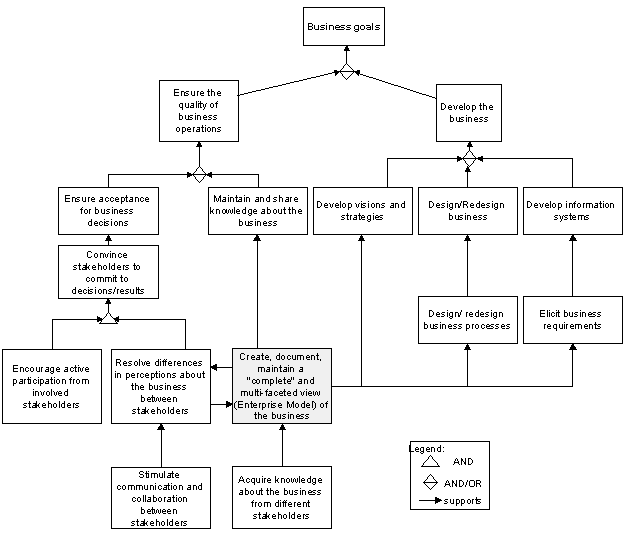The purpose of using EKD

Enterprise Modelling(EM) and therefore EKD can be used for a number
of purposes. The goal hierarchy above shows the common objectives that
organisations have for using Enterprise Modelling. It contains two main
branches. One dealing with developing the business, e.g. developing business
vision, strategies, redesigning the way the business operates, developing
the supporting information systems, etc. The other dealing with ensuring
the quality of the business, primarily focusing on two issues:
1) sharing the knowledge about the business, its vision, the
way it operates and
2) ensuring the acceptance of business decisions through committing
the stakeholders to the decisions made.
Business development goals
Business development is one of the most common objectives for using EM.
Business development frequently involves change management – determining
how to achieve visions and objectives from the current state in organisations.
Enterprise Modelling is used in this process with great success.
Business process orientation is a specific case of business development
– the organisation wants to restructure/redesign its business operations.
Also, EM is commonly used in the early stages of system development.
A common view among business consultants is that EM can effectively be
used for gathering the business needs and high-level.
Quality assurance goals
Another common reason why many organisations decide to adopt EM is to ensure
the quality of its operations. Two important success factors for ensuring
quality, mentioned by interviewees were that stakeholders understand the
business and that they accept/are committed to business decisions.
Recently, organisations have taken an increased interest in Knowledge
Management, which is concerned with creating, maintaining and disseminating
organisational knowledge between stakeholders in order for them to understand
the business. EM has a role to play here, since its aim is to create a
multifaceted view of the business. As one interviewee expressed:
To maintain and share knowledge about the business becomes extra important
in the situation where two organisations are integrated or where different
organisations collaborate and have different roles in carrying out a business
process. One of the knowledge management perspectives is keeping the employees
informed with regard to how the business is done.
If Enterprise Models are to play a role in the maintenance and dissemination
of business knowledge there is a need for supporting tools.
Most modern organisations subscribe to the view that the commitment
of stakeholders to carry out business decisions is a critical success factor
for achieving high quality business operations. To this effect, differences
in opinions about the business must be resolved; in turn requiring that
communication between stakeholders is stimulated. EM, particularly using
a participative way of working, is effective to obtain commitment from
stakeholders.
[BACK]

